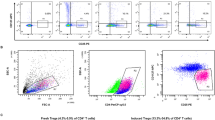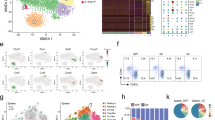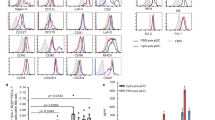Abstract
Peripherally derived CD11b+ myeloid dendritic cells (mDCs), plasmacytoid DCs, CD8α+ DCs and macrophages accumulate in the central nervous system during relapsing experimental autoimmune encephalomyelitis (EAE). During acute relapsing EAE induced by a proteolipid protein peptide of amino acids 178–191, transgenic T cells (139TCR cells) specific for the relapse epitope consisting of proteolipid protein peptide amino acids 139–151 clustered with mDCs in the central nervous system, were activated and differentiated into T helper cells producing interleukin 17 (TH-17 cells). CNS mDCs presented endogenously acquired peptide, driving the proliferation of and production of interleukin 17 by naive 139TCR cells in vitro and in vivo. The mDCs uniquely biased TH-17 and not TH1 differentiation, correlating with their enhanced expression of transforming growth factor-β1 and interleukins 6 and 23. Plasmacytoid DCs and CD8α+ DCs were superior to macrophages but were much less efficient than mDCs in presenting endogenous peptide to induce TH-17 cells. Our findings indicate a critical function for CNS mDCs in driving relapses in relapsing EAE.
This is a preview of subscription content, access via your institution
Access options





Similar content being viewed by others
References
Vanderlugt, C.L. & Miller, S.D. Epitope spreading in immune-mediated diseases: implications for immunotherapy. Nat. Rev. Immunol. 2, 85–95 (2002).
Tuohy, V.K., Yu, M., Yin, L., Kawczak, J.A. & Kinkel, R.P. Spontaneous regression of primary autoreactivity during chronic progression of experimental autoimmune encephalomyelitis and multiple sclerosis. J. Exp. Med. 189, 1033–1042 (1999).
Lehmann, P.V., Forsthuber, T., Miller, A. & Sercarz, E.E. Spreading of T-cell autoimmunity to cryptic determinants of an autoantigen. Nature 358, 155–157 (1992).
McRae, B.L., Vanderlugt, C.L., Dal Canto, M.C. & Miller, S.D. Functional evidence for epitope spreading in the relapsing pathology of experimental autoimmune encephalomyelitis. J. Exp. Med. 182, 75–85 (1995).
Vanderlugt, C.L. et al. Pathologic role and temporal appearance of newly emerging autoepitopes in relapsing experimental autoimmune encephalomyelitis. J. Immunol. 164, 670–678 (2000).
Yu, M., Johnson, J.M. & Tuohy, V.K. A predictable sequential determinant spreading cascade invariably accompanies progression of experimental autoimmune encephalomyelitis: A basis for peptide-specific therapy after onset of clinical disease. J. Exp. Med. 183, 1777–1788 (1996).
Miller, S.D. et al. Persistent infection with Theiler's virus leads to CNS autoimmunity via epitope spreading. Nat. Med. 3, 1133–1136 (1997).
Katz-Levy, Y. et al. Temporal development of autoreactive Th1 responses and endogenous antigen presentation of self myelin epitopes by CNS-resident APCs in Theiler's virus-infected mice. J. Immunol. 165, 5304–5314 (2000).
Neville, K.L., Padilla, J. & Miller, S.D. Myelin-specific tolerance attenuates the progression of a virus-induced demyelinating disease: Implications for the treatment of MS. J. Neuroimmunol. 123, 18–29 (2002).
Hohlfeld, R. & Wekerle, H. Autoimmune concepts of multiple sclerosis as a basis for selective immunotherapy: from pipe dreams to (therapeutic) pipelines. Proc. Natl. Acad. Sci. USA 101, 14599–14606 (2004).
Park, H. et al. A distinct lineage of CD4 T cells regulates tissue inflammation by producing interleukin 17. Nat. Immunol. 6, 1133–1141 (2005).
Chen, Y. et al. Anti-IL-23 therapy inhibits multiple inflammatory pathways and ameliorates autoimmune encephalomyelitis. J. Clin. Invest. 116, 1317–1326 (2006).
Langrish, C.L. et al. IL-23 drives a pathogenic T cell population that induces autoimmune inflammation. J. Exp. Med. 201, 233–240 (2005).
Yen, D. et al. IL-23 is essential for T cell-mediated colitis and promotes inflammation via IL-17 and IL-6. J. Clin. Invest. 116, 1310–1316 (2006).
Nakae, S. et al. Antigen-specific T cell sensitization is impaired in IL-17-deficient mice, causing suppression of allergic cellular and humoral responses. Immunity 17, 375–387 (2002).
Nakae, S., Nambu, A., Sudo, K. & Iwakura, Y. Suppression of immune induction of collagen-induced arthritis in IL-17-deficient mice. J. Immunol. 171, 6173–6177 (2003).
Bettelli, E. et al. Reciprocal developmental pathways for the generation of pathogenic effector TH17 and regulatory T cells. Nature 441, 235–238 (2006).
Mangan, P.R. et al. Transforming growth factor-β induces development of the TH17 lineage. Nature 441, 231–234 (2006).
Veldhoen, M., Hocking, R.J., Atkins, C.J., Locksley, R.M. & Stockinger, B. TGFβ in the context of an inflammatory cytokine milieu supports de novo differentiation of IL-17-producing T cells. Immunity 24, 179–189 (2006).
Veldhoen, M., Hocking, R.J., Flavell, R.A. & Stockinger, B. Signals mediated by transforming growth factor-β initiate autoimmune encephalomyelitis, but chronic inflammation is needed to sustain disease. Nat. Immunol. 7, 1151–1156 (2006).
Bailey, S.L., Carpentier, P.A., McMahon, E.J., Begolka, W.S. & Miller, S.D. Innate and adaptive immune responses of the central nervous system. Crit. Rev. Immunol. 26, 149–188 (2006).
Tompkins, S.M. et al. De novo central nervous system processing of myelin antigen is required for the initiation of experimental autoimmune encephalomyelitis. J. Immunol. 168, 4173–4183 (2002).
Kawakami, N. et al. The activation status of neuroantigen-specific T cells in the target organ determines the clinical outcome of autoimmune encephalomyelitis. J. Exp. Med. 199, 185–197 (2004).
Archambault, A.S., Sim, J., Gimenez, M.A. & Russell, J.H. Defining antigen-dependent stages of T cell migration from the blood to the central nervous system parenchyma. Eur. J. Immunol. 35, 1076–1085 (2005).
Greter, M. et al. Dendritic cells permit immune invasion of the CNS in an animal model of multiple sclerosis. Nat. Med. 11, 328–334 (2005).
Matyszak, M.K. & Perry, V.H. The potential role of dendritic cells in immune-mediated inflammatory diseases in the central nervous system. Neuroscience 74, 599–608 (1996).
Serot, J.M., Foliguet, B., Bene, M.C. & Faure, G.C. Ultrastructural and immunohistological evidence for dendritic-like cells within human choroid plexus epithelium. Neuroreport 8, 1995–1998 (1997).
Hanly, A. & Petito, C.K. HLA-DR-positive dendritic cells of the normal human choroid plexus: a potential reservoir of HIV in the central nervous system. Hum. Pathol. 29, 88–93 (1998).
McMenamin, P.G. Distribution and phenotype of dendritic cells and resident tissue macrophages in the dura mater, leptomeninges, and choroid plexus of the rat brain as demonstrated in wholemount preparations. J. Comp. Neurol. 405, 553–562 (1999).
Suter, T. et al. The brain as an immune privileged site: dendritic cells of the central nervous system inhibit T cell activation. Eur. J. Immunol. 33, 2998–3006 (2003).
McMahon, E.J., Bailey, S.L., Castenada, C.V., Waldner, H. & Miller, S.D. Epitope spreading initiates in the CNS in two mouse models of multiple sclerosis. Nat. Med. 11, 335–339 (2005).
Newman, T.A., Galea, I., van Rooijen, N. & Perry, V.H. Blood-derived dendritic cells in an acute brain injury. J. Neuroimmunol. 166, 167–172 (2005).
Fischer, H.G. & Bielinsky, A.K. Antigen presentation function of brain-derived dendriform cells depends on astrocyte help. Int. Immunol. 11, 1265–1274 (1999).
Santambrogio, L. et al. Developmental plasticity of CNS microglia. Proc. Natl. Acad. Sci. USA 98, 6295–6300 (2001).
Hickey, W.F. & Kimura, H. Perivascular microglial cells of the CNS are bone marrow-derived and present antigen in vivo. Science 239, 290–292 (1988).
Greenwald, R.J., Freeman, G.J. & Sharpe, A.H. The B7 family revisited. Annu. Rev. Immunol. 23, 515–548 (2005).
McMahon, E.J., Bailey, S.L. & Miller, S.D. CNS dendritic cells: critical participants in CNS inflammation. Neurochem. Int. 49, 195–203 (2006).
Ye, P. et al. Requirement of interleukin 17 receptor signaling for lung CXC chemokine and granulocyte colony-stimulating factor expression, neutrophil recruitment, and host defense. J. Exp. Med. 194, 519–527 (2001).
Antonysamy, M.A. et al. Evidence for a role of IL-17 in organ allograft rejection: IL-17 promotes the functional differentiation of dendritic cell progenitors. J. Immunol. 162, 577–584 (1999).
Shortman, K. & Liu, Y.J. Mouse and human dendritic cell subtypes. Nat. Rev. Immunol. 2, 151–161 (2002).
Maldonado-Lopez, R. et al. CD8α+ and CD8 α− subclasses of dendritic cells direct the development of distinct T helper cells in vivo. J. Exp. Med. 189, 587–592 (1999).
Gutcher, I. et al. Interleukin 18–independent engagement of interleukin 18 receptor-α is required for autoimmune inflammation. Nat. Immunol. 7, 946–953 (2006).
Plumb, J., Armstrong, M.A., Duddy, M., Mirakhur, M. & McQuaid, S. CD83-positive dendritic cells are present in occasional perivascular cuffs in multiple sclerosis lesions. Mult. Scler. 9, 142–147 (2003).
Serafini, B. et al. Dendritic cells in multiple sclerosis lesions: maturation stage, myelin uptake, and interaction with proliferating T cells. J. Neuropathol. Exp. Neurol. 65, 124–141 (2006).
Nestle, F.O. et al. Plasmacytoid predendritic cells initiate psoriasis through interferon-alpha production. J. Exp. Med. 202, 135–143 (2005).
Jongbloed, S.L. et al. Enumeration and phenotypical analysis of distinct dendritic cell subsets in psoriatic arthritis and rheumatoid arthritis. Arthritis Res. Ther. 8, R15 (2006).
Farkas, L., Beiske, K., Lund-Johansen, F., Brandtzaeg, P. & Jahnsen, F.L. Plasmacytoid dendritic cells (natural interferon-α/β-producing cells) accumulate in cutaneous lupus erythematosus lesions. Am. J. Pathol. 159, 237–243 (2001).
Ludewig, B., Odermatt, B., Landmann, S., Hengartner, H. & Zinkernagel, R.M. Dendritic cells induce autoimmune diabetes and maintain disease via de novo formation of local lymphoid tissue. J. Exp. Med. 188, 1493–1501 (1998).
Drayton, D.L., Ying, X., Lee, J., Lesslauer, W. & Ruddle, N.H. Ectopic LT αβ directs lymphoid organ neogenesis with concomitant expression of peripheral node addressin and a HEV-restricted sulfotransferase. J. Exp. Med. 197, 1153–1163 (2003).
Magliozzi, R., Columba-Cabezas, S., Serafini, B. & Aloisi, F. Intracerebral expression of CXCL13 and BAFF is accompanied by formation of lymphoid follicle-like structures in the meninges of mice with relapsing experimental autoimmune encephalomyelitis. J. Neuroimmunol. 148, 11–23 (2004).
Yoneyama, H. et al. Evidence for recruitment of plasmacytoid dendritic cell precursors to inflamed lymph nodes through high endothelial venules. Int. Immunol. 16, 915–928 (2004).
Vecchi, A. et al. Differential responsiveness to constitutive vs. inducible chemokines of immature and mature mouse dendritic cells. J. Leukoc. Biol. 66, 489–494 (1999).
Pashenkov, M. et al. Two subsets of dendritic cells are present in human cerebrospinal fluid. Brain 124, 480–492 (2001).
Huang, Y.M. et al. Multiple sclerosis is associated with high levels of circulating dendritic cells secreting pro-inflammatory cytokines. J. Neuroimmunol. 99, 82–90 (1999).
El Behi, M. et al. New insights into cell responses involved in experimental autoimmune encephalomyelitis and multiple sclerosis. Immunol. Lett. 96, 11–26 (2005).
Sanna, A. et al. Glatiramer acetate reduces lymphocyte proliferation and enhances IL-5 and IL-13 production through modulation of monocyte-derived dendritic cells in multiple sclerosis. Clin. Exp. Immunol. 143, 357–362 (2006).
Stasiolek, M. et al. Impaired maturation and altered regulatory function of plasmacytoid dendritic cells in multiple sclerosis. Brain 129, 1293–1305 (2006).
Lopez, C., Comabella, M., Al-Zayat, H., Tintore, M. & Montalban, X. Altered maturation of circulating dendritic cells in primary progressive MS patients. J. Neuroimmunol. 175, 183–191 (2006).
Ochando, J.C. et al. Alloantigen-presenting plasmacytoid dendritic cells mediate tolerance to vascularized grafts. Nat. Immunol. 7, 652–662 (2006).
Waldner, H., Whitters, M.J., Sobel, R.A., Collins, M. & Kuchroo, V.K. Fulminant spontaneous autoimmunity of the central nervous system in mice transgenic for the myelin proteolipid protein-specific T cell receptor. Proc. Natl. Acad. Sci. USA 97, 3412–3417 (2000).
Begolka, W.S., Vanderlugt, C.L., Rahbe, S.M. & Miller, S.D. Differential expression of inflammatory cytokines parallels progression of central nervous system pathology in two clinically distinct models of multiple sclerosis. J. Immunol. 161, 4437–4446 (1998).
Acknowledgements
We thank A. Dzionek (Miltenyi Biotec) for providing anti-PDCA-1; J. Marvin (Northwestern University) for cell sorting; M. Degutes for technical assistance; and colleagues at the Myelin Repair Foundation for discussions. Supported by the National Institutes of Health (NS-30871 and NS-26543; and AI-07476 to E.J.M.), the National Multiple Sclerosis Society (RG 3793-A-7; and FG 1563 A-1 to S.L.B.), the Myelin Repair Foundation, and Deutsche Forschungsgemeinschaft (B.S.).
Author information
Authors and Affiliations
Contributions
S.L.B. did most of the experiments; B.S. did the intracellular cytokine staining of 139TCR cells recovered from the CNS and helped with purification and phenotypic analysis of the CNS APC subsets; E.J.M. assisted with the immunohistochemistry; and S.D.M. provided intellectual input, secured the funding and guided the preparation of the manuscript.
Corresponding author
Ethics declarations
Competing interests
The authors declare no competing financial interests.
Supplementary information
Supplementary Fig. 1
Dendritic cells accumulate in the CNS of mice during relapsing EAE. (PDF 335 kb)
Supplementary Fig. 2
DC subsets and macrophages internalize myelin debris in the inflamed CNS. (PDF 271 kb)
Supplementary Fig. 3
MHC II and accessory molecule expression by DC subsets in the inflamed CNS. (PDF 239 kb)
Rights and permissions
About this article
Cite this article
Bailey, S., Schreiner, B., McMahon, E. et al. CNS myeloid DCs presenting endogenous myelin peptides 'preferentially' polarize CD4+ TH-17 cells in relapsing EAE. Nat Immunol 8, 172–180 (2007). https://doi.org/10.1038/ni1430
Received:
Accepted:
Published:
Issue Date:
DOI: https://doi.org/10.1038/ni1430
This article is cited by
-
Impact of disease-modifying therapy on dendritic cells and exploring their immunotherapeutic potential in multiple sclerosis
Journal of Neuroinflammation (2022)
-
Apigenin Modulates Dendritic Cell Activities and Curbs Inflammation Via RelB Inhibition in the Context of Neuroinflammatory Diseases
Journal of Neuroimmune Pharmacology (2021)
-
Engineered immunological niches to monitor disease activity and treatment efficacy in relapsing multiple sclerosis
Nature Communications (2020)
-
On the immunoregulatory role of statins in multiple sclerosis: the effects on Th17 cells
Immunologic Research (2019)
-
Targeting DEC-205−DCIR2+ dendritic cells promotes immunological tolerance in proteolipid protein-induced experimental autoimmune encephalomyelitis
Molecular Medicine (2018)



